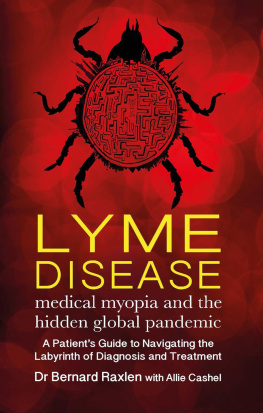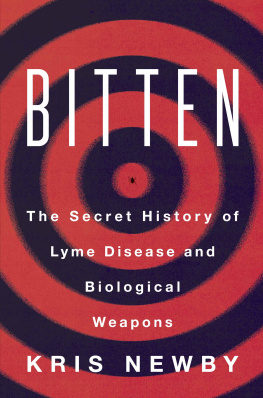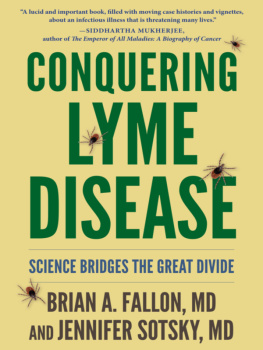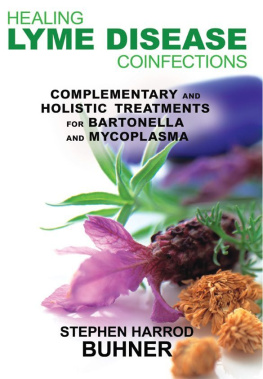Lyme Disease
Lyme Disease
The Ecology of a Complex System
RICHARD S. OSTFELD


Oxford University Press, Inc., publishes works that further
Oxford Universitys objective of excellence
in research, scholarship, and education.
Oxford New York
Auckland Cape Town Dar es Salaam Hong Kong Karachi
Kuala Lumpur Madrid Melbourne Mexico City Nairobi
New Delhi Shanghai Taipei Toronto
With offices in
Argentina Austria Brazil Chile Czech Republic France Greece
Guatemala Hungary Italy Japan Poland Portugal Singapore
South Korea Switzerland Thailand Turkey Ukraine Vietnam
Copyright 2011 by Oxford University Press, Inc.
Published by Oxford University Press, Inc.
198 Madison Avenue, New York, New York 10016
www.oup.com
Oxford is a registered trademark of Oxford University Press
All rights reserved. No part of this publication may be reproduced,
stored in a retrieval system, or transmitted, in any form or by any means,
electronic, mechanical, photocopying, recording, or otherwise,
without the prior permission of Oxford University Press.
Library of Congress Cataloging-in-Publication Data
Ostfeld, Richard S., 1954
Lyme disease : the ecology of a complex system / Richard S. Ostfeld.
p. ; cm.
Includes bibliographical references and index.
ISBN 9780195388121
1. Lyme diseaseEnvironmental aspects. 2. Lyme diseaseEpidemiology.
I. Title.
[DNLM: 1. Lyme Diseaseepidemiology. 2. Arachnid Vectors.
3. Ecosystem. 4. Lyme Diseasetransmission. 5. Risk Factors. WC 406 O85e 2010]
RA644.L94O88 2010
614.5746dc22 2010000805
1 3 5 7 9 8 6 4 2
Printed in the United States of America
on acid-free paper
For Felicia
Contents
Preface
G RADUATE STUDENTS GENERALLY SOCIALIZE WITH OTHER ACADEMICS and feel less comfortable hobnobbing in broader social strata. So I was mildly distressed to find myself at a cocktail party in 1985 faced with making conversation with a group of unfamiliar nonscientists. To get the ball rolling, I asked members of the circle what they did for a living. I learned that my small social group consisted of a marketer for a winery, an attorney, and an insurance broker. Their professions elicited no particular reaction from the others. But when I reported that I was a biologist, I was peppered with questions about what I really do. Pleased with the attention, I began to describe the wonders of studying animals in their natural habitats, only to be confronted by the insurance salesman with the question: But what does that contribute to society? My initial (silent) response was: Well, at least I dont convince people to buy things they dont really need. But I realized that the real challenge was to pithily describe to nonscientists why the pursuit of basic knowledge is worthwhile. I dont recall exactly how I answered, but my impression was that I did a poor job convincing these folks that knowing how nature works provides any tangible benefits to their lives. At the time, I was working on the territorial behavior of a rodent called the California vole (Microtus californicus), and perhaps its importance was a hard sell. Ever since that evening, Ive felt that I need to be equipped to describe to any audiencescientific or notwhy my science is important. If I fail to do so, perhaps the problem is not having an impenetrably dense audience, but rather having an insufficiently compelling research specialty.
The purpose of this book is to describe my understanding, based on the past 30 years of work by many excellent researchers, of where in nature Lyme disease comes from. What increases Lyme disease risk, what decreases it, why are there hotspots and bad years, and why is it spreading? The book is all about biology, from the spirochete bacterium (Borrelia burgdorferi) that causes the disease, to the tick vector, to the many animals ticks feed on, their habitats, the climate, the landscape, and beyond. So the natural audience for this book consists of ecologists, entomologists, epidemiologists, public health specialists, and students of all these disciplines. But I have tried to write the book so that nonscientists can follow the arguments. Perhaps Im still trying to answer the insurance salesman. If he is among the many millions of people who live in the areas hard hit by this disease or is among the hundreds of thousands of past and current sufferers, perhaps he will be motivated to learn more about its ecology. This book will not give society a complete prescription for how to avoid or prevent Lyme disease, but there is practical information for those looking to reduce their odds of encountering an infected tick. One of the main points for nonbiologist readers, though, is that research in the science of ecology is useful for a variety of reasons, including helping protect human health.
My parents tell me that as a child I had a habit of being contrarian. The famous family story (and I would wager its apocryphal) is that, as I was putting on my jacket to go outside for an afternoon of playing ball, my mother said: Have a good time, to which I reportedly responded: Dont tell me what to do. Regardless of this particular storys veracity, I admit to being an iconoclast by nature. In 1991, about a year into my current academic position at the Cary Institute of Ecosystem Studies in Millbrook, New York, I began a new field research project that involved studying populations of white-footed mice (Peromyscus leucopus). I was collaborating with my new colleagues Charles Canham, Clive Jones, and Gary Lovett in asking whether mice could prevent a forest pest, the gypsy moth (Lymantria dispar), from undergoing outbreaks and killing millions of trees. So initially this research had nothing to do with Lyme disease.
Field research on mice typically involves trapping them in small metal box traps and then inspecting and marking them before letting them go. The mice at the Cary Institute were typical of the many thousands of other rodents I had previously trapped except for one featuretheir ears were covered with the ticks responsible for transmitting the Lyme disease bacterium. Thus began my interest in Lyme disease ecology. Small rodents like mice were notorious for undergoing boom and bust cycles, and many scientists were researching the causes of these fluctuations. I decided to ask what the consequences of those fluctuations might be for tick populations and Lyme disease risk.
To undertake a new research project in an unfamiliar area, a scientist needs to start by reading the pertinent literature. In doing so, I was impressed by how much of the ecology of Lyme disease had been worked out in the 15 or so years since the disease was first discovered. But the picture that this literature painted of Lyme disease ecology seemed much too simple. It focused on only a small subset of the species that ticks feed on, and it was limited to few habitats, processes, and seasons. As I continued with my research on mice, deer, other vertebrates, ticks, spirochetes, and their habitats, the data my group collected were often inconsistent with the concepts advocated by prior research. The discrepancies are described in detail in the chapters that follow; suffice it to say that my iconoclastic nature led me to question the dogma that permeated the literature. Of course, questioning paradigms is only a part of the scientific processto advance our knowledge, one must contribute to the replacement of prior views with new understanding. That is what I have tried to do in my research, and what I try to do in this book.
Next page







